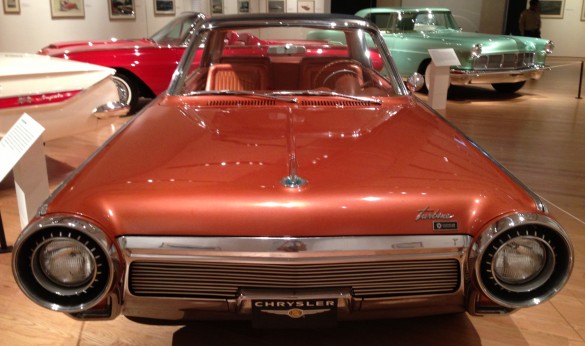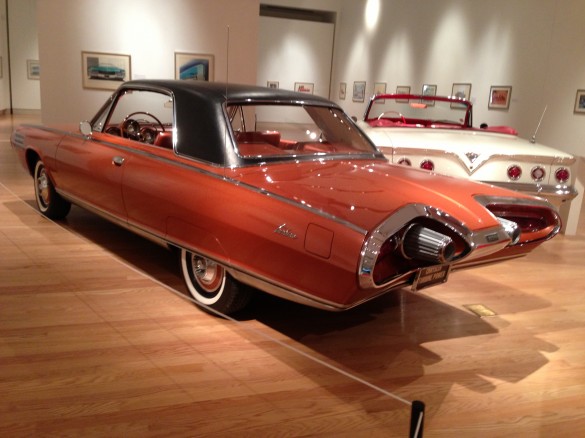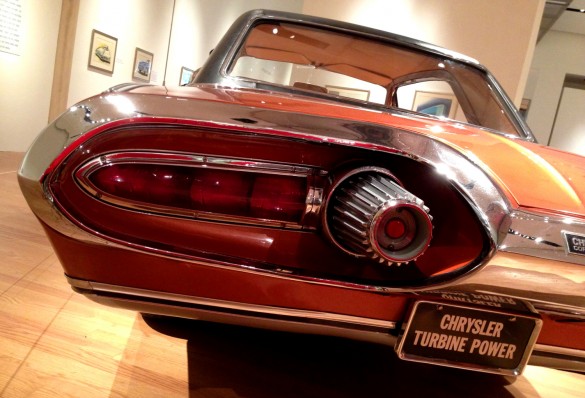Dart right over, Caravan the family, it won’t Bug us if you pick up friends and Escape to The Cummer. The parking lot is done and ready to receive you in your Prius or your Pinto, your Cube or your Mini Cooper, your Harley or your Schwinn. And as long as you are parked, come in to the Mason and Stein Galleries and see what is parked there. Study the images on the walls of the Stein and imagine parking some of these vehicles.

Check out the 1963 Chrysler Turbine, a car with a jet engine or at least it sounds like one when it runs. Basically a gas turbine engine works by compressing air, forcing the air into a combustion chamber where it is mixed with fuel and ignited. The resulting directed “explosion” spins the turbines converting the energy from the expanding gases into mechanical work. This work can move a body directly or create electricity to be used later on. Actually the first gas powered turbine was patented in 1791 by John Barber, though technology did not catch up until the early 20th century allowing the production of a useful machine.

From the beginning the turbine engine (gas or steam) was tried out in the “horseless carriage”, with the 1963 Chrysler Turbine being one such experiment. Chrysler worked on their turbine technology through the end of the 1970’s but concluded at that time that turbines didn’t have the emissions and fuel-economy advantages to overcome the costs of materials and production. However, it is not a dead technology, mini gas turbines are showing up in hybrids like the Jaguar C-X75 where two of the turbines are used to produce electricity when the battery is low. Maybe not the jet propulsion across town you were looking for but you could still have your turbo car and park it too.

Perhaps, you are tired of traffic and would like to fly around town in your own personal vehicle; a dream that has been around a long time from the Da Vinci’s helicopter to Chitty Chitty Bang Bang. Flying cars have taken to the air as early as 1937 (the Waterman Aerobile) and continue to do so today (Terrafugia Transition). Early versions required that the wings be removed for the road and reattached for the air but latest versions allow the wings to fold and unfold automatically. Yet we have not come up with reasonable flying car that eliminates the runway. To get a car into the air (on its own power – no trebuchet) we need to consider; L = Cl X rV2/2 X A and probably F/W, not to mention L/D and more. These formulas enter into the size, weight (including passengers) and take off (if F/W > 1 then the vehicle can accelerate vertically) considerations. So you can see the problems flying car designers are up against.

Yet I am not discouraged, even though some of the represented concepts of turbo powered or flying vehicles appear not to be ready for prime time, I have confidence that the dreams of these artists can be realized once technology catches up. And so many times the art pushes the science, after all who would have thought that my Star Trek flip phone would be deemed out of date by my students, get with it Mr. Karl, this is the 21st century.
[Okay, I’ll tell you: L = Cl X rV2/2 X A is the “Lift Equation” where L is lift, Cl is a variable called the lift coefficient, r is air density and A is the wing area. F/W is the Thrust to Weight Ratio and L/D is the Lift to Drag Ratio where F is thrust, W is weight, L is lift and D is drag. https://www.grc.nasa.gov/WWW/k-12/airplane]


